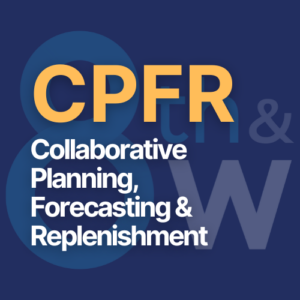It is very difficult to predict retail sales. Every analyst knows what standard peak times are for their category, but each year brings new opportunities (good and bad!). Shopping trends, unexpected demand, severe weather, and new retailer expectations have all altered suppliers’ plans over the last few years.
Analysts have more data to consider when preparing their retail forecasts. As we will explore in this article, retail forecasting requires more than researching historical sales data. More accurate forecasts require a varying amount of input to create more accurate plans to grow sales.
What Is Retail Forecasting?
Retail forecasting is the process of using data and analytics over a set period of time to predict future performance for the purpose of making adjustments to pricing, supply chain, and marketing to improve sales.
As analysts develop strategies for sales growth, their focus in retail forecasting is made up of two components:
1. Demand Forecasting
Demand forecasting is using the data, analytics, shopper behavior, and information about your customer to predict future demand for your product or service.
What analysts are trying to discover through demand forecasting is how likely customers will be to buy a given product or service at a specific time for a price acceptable to them. The more accurate the demand forecast is, the better it can be used to make better decisions throughout the entire supply chain.
Consumer demand impacts planning for product development, replenishment, inventory capacity, and pricing.
2. Sales Forecasting
Sales forecasting is the act of analyzing sales data and trends to predict future revenue by estimating how much of an item or service will be purchased in a given time period (weeks, months, quarters, or years).
The specific methods by which an analyst measures sales can vary by industry. However, the majority of sales forecasts rely on a company’s historical sales data and current shopping trends to make the best predictions and plans for future sales.
Why Is Retail Forecasting Important?
Accurate retail forecasting is essential for analysts to make decisions for planning resources, supplying stores and distribution centers, pricing, allocating capacity, and more. All of these decisions are founded on the one critical task that is the basis for prioritizing your retail forecasting process: maintaining efficient inventory levels.
Many issues between the retailer and the supplier can be attributed to too much inventory or too little inventory. Finding that “just right” quantity is not always easy, and is what makes retail forecasting important.
- Too much inventory: If an inaccurate forecast results in too much inventory, loss can be costly at the store level. Too much inventory can result in lost revenue in the form of markdowns, clearance sales, destroyed product due to expiration dates, or returns to the supplier.
- Too little inventory: If an inaccurate forecast results in too little inventory, loss can be monetary and in customer loyalty. With not enough product to meet customer demand, those sales can go to a competitor. Enough out-of-stocks can also lead to less or even no space on future modulars.
Retail forecasting for accurate inventory planning is the first step in making other decisions for supply chain success. The right forecast helps the supplier grow sales, manage inventory levels, control pricing, prevent loss of revenue, and maintain customer satisfaction.
What Variables Impact Retail Demand Planning?
Nothing in retail is an exact science. No matter how much research is before you or how deeply you analyzed the numbers, unexpected factors can disrupt the best retail forecast. Some variables to be aware of include:
Customer vs. Store
If you are a Walmart supplier, you already know the Walmart shopper in Bentonville, AR, is very different from the Walmart shopper in Oceanside, CA. However, a good retail analyst will also recognize that two Walmart stores less than five miles apart can also have drastically different customers. The community around each store can represent different shopping patterns, needs, and interests. This will have a big impact on forecasted sales, even for stores within the same area. A supplier can not expect to supply the same assortment and quantities to all stores.
Seasonal Shifts
If a supplier is selling to a national chain like Walmart, Target, or Kroger, the word “seasonality” takes on a greater meaning when forecasting sales and customer demand. Most suppliers anticipate a seasonal bump in sales and demand around the end-of-year holidays and the back-to-school shopping season. What national suppliers must also factor in are regional seasonal bumps. For example, Mardi Gras decorations, costumes, and cakes will be in higher demand in Louisiana than in Maine. That’s an obvious example but shows how being in tune with seasonality at the local level will only improve the forecast for national sales.
Price Fluctuation and Perception
The old rule of sales was if you want to drive volume, simply lower your price. However, many factors contribute to an item’s price outside of production cost. Analysts have to consider current market conditions, future promotions, competition, and customer expectations when setting a price. Also, not all products have a positive result from a lower price. A customer looking at a $1,100 laptop versus a $300 laptop may be willing to spend more money believing the later is of poor quality.
Spikes from Promotions
The impact of a promotional spike on customer demand is tricky to forecast. Trying to predict an increase from a promotion requires understanding customer perceptions as well as examining the channels of the offering. Simply put, how a customer reacts to an online promotion (rebate, bonus buy, special offer) may be very different than how they react to the same promotion in a brick-and-mortar store.
Order Placement vs. Future Demand
Whether you are a retailer ordering product or a supplier ordering product parts, the lead time on placing the order versus having it delivered can be a challenge without knowing future demand. Having to place orders many months out creates a huge degree of variability that can impact the availability of your products against a potentially unknown consumer demand.
Competing Items
Retail forecasting is more than looking at your past performance and shopping trends. It is also being aware of who is competing for your customer, how much space they occupy, their promotions and special offers, and if their actions had a direct impact on your performance.
Retail Forecasting Methods
In order to present the most accurate forecast for their business, analysts use one or more different methods. Some of the methods today’s analysts use include:
Time-Series Forecasts
Time-series forecasting looks at sales data to call out the various growth rates, cycles, trends, and seasonality. The drawback to the time-series forecast is it relies on past sales to predict future demand. Used for long-term planning, inaccuracies can occur.
Qualitative Forecasts
Qualitative forecasts take into account current market trends and consumer research. Analysts examine data outside of past sales, like market research, consumer feedback, and industry expert opinions and analysis. Customer confidence is also an important factor in qualitative forecasts.
Causal modeling
Causal modeling aims to achieve an accurate forecast by gathering data to build simulations and make plans from the result. The data used in casual modeling can cover external factors that impact the internal cost of your business. For example, a casual model may take into account what your company is spending on advertising as well a local economy or regional gas prices. To process and analyze this varying data, analysts usually rely on forecasting software and AI to assist in making decisions.
How to Forecast Retail Sales
Like any good business plan, there is no “cookie-cutter” approach that works for everyone every time. If you are a new analyst and just need a general guide when approaching your first project in forecasting, these five steps are good building blocks to lay out goals:
1. Gather and Examine Historical Data
Pull sales, events, promotions, obstacles, and all pertinent information from the previous year. Dig into the numbers as they break out by price, item, sales location, sales period, and other helpful criteria. This will lay the foundation for your forecast.
2. Factor in Changes
Once you have your sales information, it’s time to begin making changes based on what you know is changing in the next year. These changes can be one or more of the following:
- Item updates/additions: Consider if you are bringing any new items to market or if you are making changes to your items and assortment. Review how long it took for previous items to gain a customer base, what worked in growing sales, and if any new items or changes may perform differently.
- Expansion/new platform: Plan for changes impacted by selling products in new stores, areas of the country, websites, or even different areas of the store.
- Pricing: If the price of your items has to change, consider the reasons why (competition, inflation, supply/demand, supply chain changes, etc.).
- Promotions: In looking at any marketing promotions in the coming year, research how similar promotions worked in the past. Closely examine the timing and other events around the promotion dates.
- New shoppers: Examine the potential of gaining new shoppers. Research new shoppers from the previous year and what factors should contribute to new shopper growth in the coming year (different marketing, new products, change in current products, distribution changes, etc.).
3. Research the Market Trends
Understand what’s happening in the market that can positively or negatively impact your sales. Market trends range from how most customers purchase your item (online, in-store, pickup) to social and political influences that can grow or hurt your item’s perception.
4. Identify and Research Competition
From major brands to small local businesses, know who else is trying to win your customer. Research their company, products, marketing, and any plans they have made public. When putting together the forecast, it also helps to factor in any new competitors launching in the coming year.
5. Build in Business Plans
Work with your team to align the forecast with the company’s business plan for the year. Take into consideration major changes the company wants to make that can impact the forecast. A product going into a new market will influence projections as well as new marketing partnerships or changes to the corporate structure.
Build all of this data into your forecast once you’ve compiled and researched. Understand that not every person in your company wants to see every part of the forecast. Different members of the team will have a higher interest in different aspects, so ensure everything is itemized — this way it can be understood in as granular a level as possible.
Demand and Sales Forecasting for Walmart
For Walmart suppliers, accurate forecasting is a huge part of the buyer relationship. Walmart buyers and suppliers work together to ensure the items are in stock and inventory levels are managed. The forecasts improve supply chain costs as well as work to improve sales. Walmart initiatives like OTIF and SQEP were put in place to hold suppliers accountable for their forecasts and make adjustments as necessary.
When working with Walmart on forecasts, specific times to make updates and present plans include:
- Changes or expansions to the modular
- Adding new items to the assortment
- Routine weekly orders
- Promotions, features, or upcoming category spike periods
- Deletions to SKUs
To learn more about pulling and analyzing Walmart sales data to formulate an accurate forecast, review 8th & Walton’s updated Walmart reporting classes.
The Bottom Line
Building a strategy based on accurate retail forecasting can be a challenge. Combining historical data with the current shopping trends and external factors takes time, but is essential for optimal inventory levels and sales growth.
The team at 8th & Walton can not only answer your questions about forecasting but also show you how to use the Walmart data accurately. Set up a free 15-minute consultation with one of our advisors to learn more about our classes and services.



